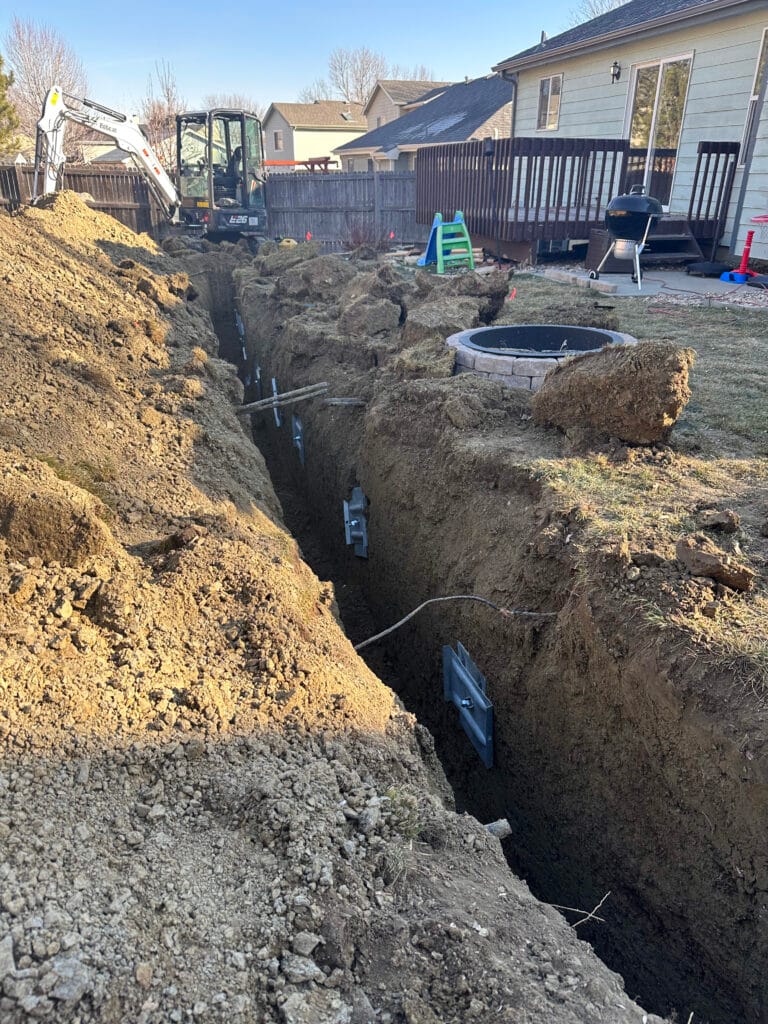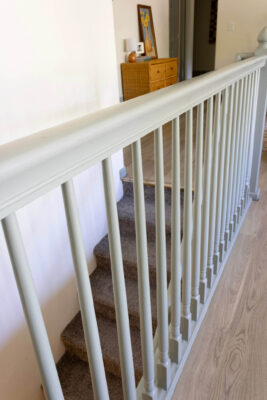Today I’m answering all your questions about how we added foundation wall anchors to our leaning foundation. The type of company we hired, repair plans, final cost, financing options, dealing with water mitigation, and more.
Installing Foundation Wall Anchors In Our Basement
It’s been a big week at the Peppermint House! We’re so relieved to have our foundation repair finally finished and out of our mind. When we discovered this repair issue two weeks after moving in to our new home, we had no idea what we were in for. It’s a relief to be on the other side of such a big, unexpected project.

Just learned you need a foundation repair on your home? I’ve been there. Head to my Foundation Repair Survival Guide for Homeowners first! It’s an incredible resource on who to call first, what expect, and how to protect yourself, your home, and your finances in the process. Read now >>
(This is Part 4 of this unexpected foundation repair series. Read Part 1, Part 2, and Part 3 here!)
What caused the leaning foundation issue?
Water!! I cannot emphasize enough how important water mitigation is around your home.
We’ve since learned that our home was unoccupied for a long time before we bought it. Before that it wasn’t maintained well. We moved in to a flooded basement in June, and quickly discovered clogged gutters and missing downspouts. The grade around our house isn’t sloped to move water away from our home either.
Water has been pooling around our foundation walls for years, creating massive amounts of hydrostatic pressure. Enough that it’s caused one of the foundation walls to shift inward 2-3″.
The solution is two-fold.
- First, we need to stabilize the leaning foundation to prevent further movement and support our home correctly.
- Then, we need to address the water mitigation issue to relieve this hydrostatic pressure.

Who We Hired To Install Foundation Wall Anchors
We hired a company that specializes in foundation repairs in Northern Colorado. I wanted to find a local company that knew our expansive soil/terrain and how to handle this repair accordingly.
Our company subcontracted a third-party structural engineer on our behalf to create the repair plans, pulled necessary city permits, and scheduled all the necessary engineering and city inspections.
Alternative Option
You could also hire an independent structural engineer to create a report for you. Then hire a contractor or construction company to complete the repair. The benefit of this option is that you won’t get oversold on repair solutions. The downside is having to manage more aspects of the project yourself.
I found two local companies who could do it. The first was Groundworks Foundation Repair. But their specialty is in waterproofing, and we felt like their recommendations were beyond what we needed.
We ultimately hired Colorado Structural Repair in Northern Colorado. CSR confirmed that our foundation had shifted and needed repaired. They advised us that there was a lot we could do outside our home to mitigate water–like regrading the soil, adding french drains, and pointing our gutter spouts away from the house–before investing in expensive solutions.

We appreciated CSR’s transparency, and when their quote came in lower than Groundworks’, plus they could start the work sooner, we decided to move forward with them.
The Repair Plans
Colorado Structural Repair (CSR) subcontracted an independent structural engineer on our behalf to create the repair plans. The owner of the company and the engineer came to the house to take measurements and inspect the property.
Once the engineer had the measurements he needed, CSR submitted the repair plans to to our city to get the proper permits. It took about 6 weeks for the permits to get approved. Once it was approved, we cleared out our basement and scheduled a time for them to start.
Here was the specific plan for our home:

Enrique and his crew of four guys showed up to our house this Tuesday and got started right away.
I shared more of the step-by-step wall anchors installation process in this post!
Can you DIY Foundation Wall Anchors?
This was not a project we ever considered doing ourselves. We were happy to hire a company with insurance, licenses, and warranties to mitigate as much risk as possible.
CSR managed every aspect of this project from start to finish, from permits to reports and inspections. We paid them a lump sum and they covered all the fees/costs involved in the project. They also provided us with a lifetime guarantee of the repair that’s transferrable if we ever sold our home.
We’re so grateful for their time, energy, and expertise. This would have taken us months to do ourselves, and the risk of doing it wrong was too big for us.
If you’re considering DIY’ing this repair, I’d advise you to consult with a structural engineer and a contractor before starting this process! Make sure you pull the necessary city permits and get the required inspections done.

What do foundation wall anchors cost?
Final Cost
The final cost for the foundation wall anchors was: $12,669.44
With the additional wall repairs (angle iron for sill plate support and beam pocket repair), our total came to: $16,769.44
Financing Options
There’s no good time for an unexpected, expensive repair.
But especially when it hit us right after moving and making a lot of other unexpected repairs already. Our savings was depleted. We needed quick cash to pay for a repair deposit, and a financing option to cover the rest.
Unless you have a solid amount in your savings, you’ll most likely need to finance this repair.
HELOC Loan
We looked into a HELOC loan, which is like a second mortgage on your home. This gets borrowed against your home’s equity. This is a great option for expensive home repairs like this.
Advantages for this option are:
- You may be able to borrow up to 85% of your home’s value.
- The repayment period could be up to 20 years.
- You can withdraw money from this account for up to 10 years, up to your approved limit.
- You can deduct interest on a HELOC on your taxes if you use the money to build or improve your home.
For us, the drawbacks were too much. Interest rates were high at the time and it felt like a tight squeeze to be adding onto our mortgage, which also had a higher interest rate (6.7% in 2023). If the repair had been more expensive, or if interest rates were lower, we would have considered this more.
Private Loan
Again, the interest rates at the time were high and this seemed like one of the least flexible, most expensive options for us.
Retirement Savings
We’ve been diligent in setting aside retirement savings over the last ten years. We were hesitant to touch this investment, knowing how much it will grow in value over time. But we had a small, random retirement account from Nathan’s first job that we hadn’t contributed to in a long time. We decided to cash out this retirement account to cover most of the repair deposit ($4,400). We set aside a portion of this cash for taxes, skimmed more from our savings, and we were able to make the repair deposit. You may be able to take out a loan against your retirement account.
0% Interest Rate Credit Card
To pay for the rest of the repair, we took out a 21-month, 0% interest rate credit card. We are very debt-conscience, and this option seemed the most unwise at first – but then we thought about it more…
This option would allow us to:
- have a small monthly payment
- and avoid hundreds (or more) of extra dollars in interest.
We plan to pay off this repair in chunks – tax returns, side hustle income, end-of-year bonus pay, extra savings. If we’re not able to pay it off before interest kicks in, we can transfer the balance to another card or a loan. There’s typically a small fee for this, but it’s definitely smaller than whatever interest we would have paid.

Next Steps
Water Mitigation
Now that our wall is stabilized with foundation wall anchors, we can turn our attention to the root cause of our foundation issue: water mitigation. We need to minimize the amount of water around house, relieving the build-up of hydrostatic pressure on our foundation.
We’re tackling this issue this project-by-project as we can. Here are our long-term plans:
- Regrading the yard, sloping away from the house.
- Adding watertight landscape fabric in a 5-foot perimeter around the house.
- Possibly adding 1-2 french drains in our backyard to move water down and away from the house.
- Optimizing our gutters for proper drainage and flow.
- Sealing any gaps between the siding, foundation, and the interior.

Monitoring For More Foundation Movement
We’ve been assured the foundation wall anchors are a permanent repair. But… is it?! Part of this process will be monitoring any further movement over the next few years. If we have any issues, CSR will come back and make more necessary repairs. We have a lifetime warranty.
Finishing Our Basement
One of the reasons we fell in love with this home was the basement’s potential. It’s all unfinished, and would double our square footage. We planned to start building in our basement right away, but the foundation repair put it all on hold.

Now that this repair is done, we are gearing up for phase one of our basement build: a guest room! Most of our family lives out of state, and we don’t have room for guests in our 1300sqft upstairs. This will be a really great addition once it’s done.
The next few years will be a balance of paying off our foundation repair, and adding to our home’s livable space. After our foundation is paid for, we’ll start building the rest of the basement:
- Second kitchen with a bar
- Third bathroom
- Office space for me
- Playroom
- Big laundry/utility room
- Storage closets
- and a Family room
Step one of this project is getting a full basement layout drawn up, with electrical and plumbing plans. We’re beyond ready to get started!

What other questions do you have about foundation wall anchors? I’ll answer them below!
Read Next…







2 Responses
These articles on your foundation issue have been beyond helpful. You explain everything so well, and it’s nice knowing we aren’t only ones experiencing problems. We have gotten a ton of rain this season, had no gutters on one side of house, and back of house gutters were blocked by overhang of shingles from when we got rood replaced 2 yrs ago. We also live on a hill with a failing retaining wall, lol. I havnt hired an engineer yet…I’ve just been regarding around perimeter and got gutters added, cleared, and fixed up, added some dry creeks and downspout extensions, and am sealing all the cracks in concrete. There are signs that it’s had an impact…ijust don’t know how bad it is yet. Hoping I can stave off any further damage and that it isn’t to a point of needing extensive foundation repair. My husband is reluctant to hire engineer to even look, and doesn’t think regrading or gutters were something worth spending time or money on. So I’m fighting this battle all by myself. Thanks for posting such a detailed account of what yall went through.
Ah I’m so sorry you’re going through all of that! You are doing the right things though!! I know that’s SO much work, but it’s better for your house to mitigate all that water! We’ve been watching for more flooding issues this spring/summer. It seems that clearing our gutters, adding downspout extensions, and regrading the soil have all really done wonders for water issues. We are on a hill as well. Our foundation company also recommended adding 5 feet of waterproof fabric under the landscaping around the perimeter of the house. We haven’t done that yet, but will try to as we redo the landscaping around the house. If you are seeing signs of a foundation issue, the earlier you can catch it and repair it, probably the better. I think there are small repairs they can make that would be less expensive than what we needed. I know it sucks to spend money on an engineering inspection… but you might end up saving yourself a lot of money in the end to catch any issues early. Or, it will give you peace of mind knowing you don’t have a problem. Keep me posted on what you find out! Or if you have any questions. You can email me at megan@hillhomelove.com too. Hoping for all the best for you!